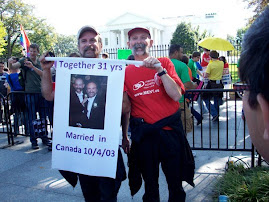I take this diversion from marriage equality to bring you a special message on gay youth
Suicide among LGBT youth is a preventable epidemic - Washington Blade: Gay and Lesbian News, Entertainment, Politics and Opinion
We must advocate for places, programs and policies that prioritize safety
By CHARLES ROBBINS
Sep. 11, 2009
WHEN TWO 11-YEAR-OLD boys died by suicide in April of this year after enduring relentless anti-gay bullying at their separate schools, shocked citizens across the country were forced to come to terms with an uncomfortable but blatant epidemic.
The hallways of schools, homes, churches and other places where all young people should be able to safely learn and grow are plagued with its tragic prevalence. Youth who identify as or are perceived to be lesbian, gay, bisexual, transgender or questioning struggle with depression and thoughts of suicide at a disproportionately high rate as a result of the increased risk factors sexual minorities face.
According to a Massachusetts Youth Risk Behavior Survey published in 2007, LGBTQ youth are up to four times more likely to attempt suicide than their heterosexual peers.
Perhaps more off-putting than this distressing fact is that only 14 states even bother to collect sexual orientation data in their Youth Risk Behavior Surveys. The remaining 72 percent of states ignore the opportunity to obtain vital information about a subculture of young people who are already all too often left without the support networks and resources they desperately need. As disheartening stories such as Carl Walker-Hoover’s and Jaheem Herrera’s (the two 11-year-old boys) surface more frequently, the harsh realities force us to address the preventable nature of these tragedies.
THIS WEEK, WE recognize National Suicide Prevention Week, and are reminded that when young people have a safe place or person to turn to in times of crisis, suicide is preventable. In fact, a 2006 survey released in “Psychology in the Schools” found that sexual minority adolescents who believed they had one school staff member with whom they could discuss problems were only one-third as likely to report making multiple suicide attempts than those without that support. Lower victimization rates and suicides among sexual minority youth also have been linked with supportive resources such as the availability of non-academic counseling, anti-bullying policies and peer support groups. Therefore, we know that when we foster safe and accepting environments to begin with, and effectively intervene when warning signs arise, we can absolutely empower young people to live.
The logistical process of ensuring that all young people, regardless of their sexual orientation or gender identity, remain safe and have access to the mental health resources they need, can seem intimidating. Yet, reaching out to youth and alerting them that resources exist is the simplest and most important step.
Call volume on The Trevor Project’s helpline reached an all-time high this summer. In the month of June alone, nearly 2,500 calls were fielded from despondent youth across the country. Nine of those callers required emergency “rescue” services to be deployed for help. But we know that despite this recent influx in calls, the tremendous need has always existed. The difference is that more young people know about our helpline now. For a parent, teacher, friend or peer to reach out and tell someone who is struggling about our services is so simple, but it is a gesture often overlooked.
THE BROADER STEPS to preventing suicide among all youth require people and communities to advocate for the safer, more inclusive environments they need. We must push for local and federal policies and mandates that provide young people with access to appropriate resources and educate them about suicide prevention and the potentially life-threatening impacts of language and behavior.
On a national level, the Safe Schools Improvement Act could potentially give schools the final push they need to implement anti-bullying policies and prevention programs that protect all students.
National Suicide Prevention Week will come and go this year. Unfortunately, for many LGBTQ young people, thoughts of depression, feelings of isolation and helplessness or hopelessness will not. As they yearn to simply be accepted and supported, we must advocate for places, programs and policies that prioritize their safety and well-being.
Friday, September 11, 2009
Suicide among LGBT youth is a preventable epidemic - Washington Blade: Gay and Lesbian News, Entertainment, Politics and Opinion
Subscribe to:
Post Comments (Atom)


No comments:
Post a Comment